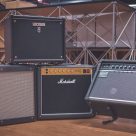The Evolution of Guitar Amplification: From Vacuum Tubes to Digital Modeling
Posted on Dec 1, 2023 in Music Instrument

The history of music is intricately intertwined with technological advancements, and perhaps nowhere is this more evident than in the evolution of guitar amplification. From the iconic warmth of vacuum tubes to the cutting-edge precision of digital modeling, the journey of guitar amplifiers has shaped the soundscapes of countless genres and defined the sonic identities of legendary musicians.
The Era of Vacuum Tubes
The origins of guitar amplification trace back to the emergence of vacuum tube technology in the early 20th century. These glass-encased wonders, powered by filaments and grids, brought forth a warm, organic tone that became synonymous with the sound of early electric guitars. The inaugural guitar amplifiers, often bulky and temperamental, harnessed the unique characteristics of vacuum tubes, giving birth to the iconic tones that shaped the blues and rock genres. From the pioneering work of inventors like Leo Fender to the legendary amplifiers of Jim Marshall, this era laid the foundation for the sonic landscapes that would define generations of music.
The Solid-State Revolution
The 1960s and 1970s witnessed a seismic shift with the advent of solid-state technology. Solid-state amplifiers, utilizing transistors instead of vacuum tubes, offered a more reliable and cost-effective alternative. While these amplifiers lacked the characteristic warmth of tubes, they introduced a new era of affordability and portability. The advent of solid-state amplification, as highlighted on the Kaotoxin audio blog, democratized the availability of amplified sound. This breakthrough has facilitated easier exploration of electrified tones for emerging artists. The distinct clean sound of solid-state amplifiers found its place in jazz, funk, and other genres, contributing to a diverse sonic landscape.

The Resurgence of Vacuum Tubes
As the music industry progressed into the late 20th century, a curious phenomenon emerged – a return to the vintage warmth of vacuum tubes. Musicians and audiophiles began to rekindle their love affair with tube-driven tones, and boutique amplifier builders capitalized on this nostalgia. The market saw the resurgence of classic designs and the birth of new, handcrafted amplifiers that sought to recapture the sonic magic of the past. This revival wasn’t merely a trend; it reflected a deep-seated appreciation for the richness and complexity that vacuum tubes brought to the world of guitar amplification.
Digital Modeling and the 21st Century
The dawn of the 21st century ushered in a revolutionary chapter with the introduction of digital modeling technology. Digital amplifiers, armed with sophisticated software algorithms, could replicate the sounds of various classic amplifiers, effects, and even acoustic environments. The advantages were clear – unparalleled versatility, convenience, and a vast array of tones at the fingertips of the modern guitarist. However, this technological leap was not without controversy. Purists debated the authenticity of digital tones, questioning whether the soulful warmth of tubes could genuinely be replicated in the digital realm. Yet, the convenience and innovation offered by digital modeling began to win over a new generation of musicians.

The Rise of Hybrid Amplifiers
In the quest for the perfect marriage of analog warmth and digital precision, hybrid amplifiers emerged as a compelling solution. These amplifiers seamlessly integrated both tube and solid-state technologies, providing a harmonious blend of vintage character and modern flexibility. Musicians now had the best of both worlds, with the option to enjoy the classic warmth of tubes while harnessing the versatility of digital effects and modeling. The rise of hybrid amplifiers reflected the evolving needs of contemporary guitarists, who sought a balance between tradition and innovation.
Future Trends in Guitar Amplification
As we stand on the precipice of a new era, it’s intriguing to speculate on the future of guitar amplification. With advancements in artificial intelligence and machine learning, the possibilities seem boundless. Imagine amplifiers that can adapt and learn from a guitarist’s playing style, or systems that can instantly replicate the tones of legendary recordings. The integration of cutting-edge technologies into amplifier design is likely to redefine the way musicians approach their craft, opening new horizons for sonic exploration in both studio and live settings.


 Jazz has much to teach us, and to teach our young people. That’s why The Dakota Foundation for Jazz Education exists. Our organization was founded in 1997 with the purpose of introducing young people to jazz and helping them understand – and care about – what they are hearing. We want to help young people use jazz for self-expression and communication, and to experience the sheer pleasure that comes from responding to its challenges. The Dakota Foundation for Jazz Education promotes jazz and jazz appreciation through education, funding development and partnerships.
Jazz has much to teach us, and to teach our young people. That’s why The Dakota Foundation for Jazz Education exists. Our organization was founded in 1997 with the purpose of introducing young people to jazz and helping them understand – and care about – what they are hearing. We want to help young people use jazz for self-expression and communication, and to experience the sheer pleasure that comes from responding to its challenges. The Dakota Foundation for Jazz Education promotes jazz and jazz appreciation through education, funding development and partnerships. 